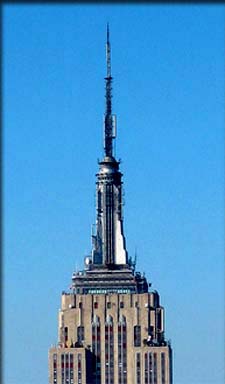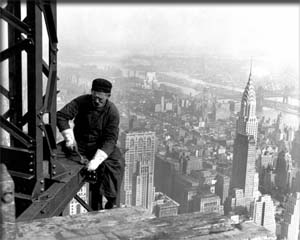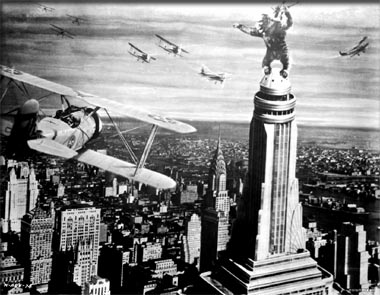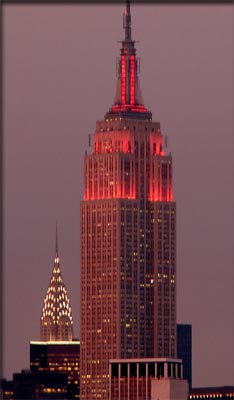 |
The
Empire State Building
|
The
beginning of the 20th century was marked by a boom of building
activity in the city of New York. Buildings were constructed
and then demolished only a few years later to make room for
larger buildings. Companies vied for the honor of having their
name on the tallest building in not only the city, but the world.
The skyline of the metropolis became its pride, crowned with
an array of skyscrapers, each one different than the one before
it.
In their
race to have their name on the tallest building, developers
would even resort to trickery. In 1930 the Bank of Manhattan
skyscraper was completed. It stood 135 feet taller than the
older Woolworth building and two feet higher than the planned
height of a rival project, the Chrysler Building, which was
still under construction. The architect of the Chrysler building,
William Van Alen, however, had a 185 foot-long spire secretly
assembled inside the building. At the end of construction on
October 23, 1929, the spire was hoisted into place and in only
90 minutes the Chrysler building usurped the Bank of Manhattan
for the title of tallest building in the world.
The
consulting architects of the Bank of Manhattan, Shreve & Lamb,
however, would soon get their revenge. Even as the Chrysler
building was being topped off, they were designing a structure
that would forever change the skyline of Manhattan and become
an icon of the city. The building they were working on would
eventually be 1,454 feet in height with 102 stories and would
carry a name that commemorated the state of New York: The Empire
State Building.
Planning
|
Seven
Quick Facts
|
| Height:
1,454ft. at antenna; 1,250 ft at roof |
| Floors:
102 |
| Finished:
May 1, 1931 |
| Cost:
$40,948,900 |
| Location:
New York City, USA |
| Made
of: "Art Deco" design with steel frame and
faced with Bedford Indiana Limestone |
| Other:
World's tallest building from 1931 to 1973
|
The
man behind the building of the Empire State Building was industrialist
John J, Raskob. The person most associated with the project,
however, was Raskob's friend, Al Smith, the former governor
of New York State. Smith was a well-liked politician and the
company Raskob and Smith put together to build the world's tallest
skyscraper took advantage of the notoriety of his former position
by naming the building in accordance with the state's nickname.
Raskob
and partners bought a parcel of land that contained the old
Waldorf-Astoria Hotel at 350 Fifth Ave. The hotel was demolished
and the architectural firm of Shreve & Lamb was engaged to design
the new building. Like many buildings of that era it was given
an "art deco" look that emphasized bold lines, symmetry, and
motifs like sunbursts and chevrons. At first the building was
designed with a flat top and was only slightly taller than the
Chrysler Building. Then, on December 11, 1929, it was announced
that the designers had decided to add a two-hundred-foot-high
mast that would be designed to moor dirigibles.
The
Mooring Mast
At that
time lighter-than-air aircrafts were considered the future wave
of transportation. The addition of a two-hundred foot mooring
mast would not only make the structure significantly taller
than the Chrysler Building, the cylindrical tower would not
be purely ornamental, but functional. A mooring mast on the
building would allow airship passengers to disembark right in
the middle of the city, rather than at some remote airfield
terminal many miles away. It was estimated a passenger might
be able to get off their dirigible at the 102nd floor, take
an elevator down the observation deck on the 86th floor, get
their luggage, and then ride another elevator to street level
and be walking on Fifth Avenue only seven minutes after their
arrival.
As attractive
as this idea was, however, it was never practical. The winds
around skyscrapers tend to be unpredictable, making docking
difficult. Also, the Empire State Building's mooring mast would
have only allowed the nose of the ship to be secured to the
building, instead of the nose and tail, which would have been
a typical arrangement at an airfield. With only the nose secured,
a sudden wind could easily tip the tail of the dirigible up
into a nearly vertical position. There was also the question
of having the passengers walk an open gangplank from the ship
to the mast with nothing below them for more than a thousand
feet. It would be an exploit that might even make passengers
not prone to acrophobia feel a bit edgy.
|

The
top of the building: The chrome-nickel steel mooring mast
was built for airships, but now is the base of a huge
antenna. (Photograph by
Jiuguang Wang and licensed under the Creative
Commons Attribution-Share Alike 2.0 Generic license)
|
The
idea of using the mast to dock airships was eventually dropped,
but the mast itself made an excellent architectural addition
to the building. Built of shining chrome-nickel steel, it was
shaped a bit like a rocket taking off, including four "fins"
or winged buttresses made of cast aluminum. At night it was
illuminated and could be seen for miles.
Construction
Construction
of the building started on March 17, 1930, with the erection
of two-hundred and ten steel columns, twelve of which would
run the entire height of the building. The construction firm
of Starrett Bros. & Eken put together a tight schedule. The
sooner the building opened, the sooner the owners could start
making money by collecting rents from tenants. The builders
used many innovative ideas to speed construction, like a chute
that allowed bricks to be dumped directly into the basement
where they could be dropped into carts as needed and hoisted
up to the floor where the work was being done. This kept the
surrounding streets clear of mountains of bricks waiting to
be used as well as eliminating the back breaking job of moving
bricks around the site by wheelbarrow.
It took
7 million man hours to complete the 365,000 ton structure. The
framework rose at a rate of 4 ½ stories per week. During the
course of construction, 3,400 workers practicing sixty trades
were involved. Workers used 57,000 tons of steel in the framework
and installed 6,500 windows. If somebody decided to walk up
he would have to climb the 1,860 steps that were put in position
to reach the 102nd floor.
|

A
worker tightens a bolt during construction of the upper
floors.
|
The
job was completed in just one year and forty-five days for $40,948,900.
It finished on time and for almost $10 million less than expected
(mainly because of depressed labor costs caused by the Great
Depression of the 1930's). The Empire State Building officially
opened on May 1, 1931, with President Herbert Hoover lighting
up the tower remotely from Washington, D.C. .
When
the building was completed it was the tallest building in the
world and the tallest man-made structure of any type. It lost
the title of tallest man-made structure in 1953 when the Griffin
Television Tower in Oklahoma was completed. It remained the
tallest free-standing structure in the world until 1967 when
it was surpassed by the Ostankino Tower.
Fame
The
building, which dominated the city skyline, soon became known
around the world as an icon of New York City. Its fame was not
in small part due to it being used as the setting for the climactic
scene of the 1933 film, King Kong. In the movie a giant
ape is captured on a remote island in the Pacific. Brought to
New York City as part of an exhibit, he escapes and carries
the film's heroine to the top of the Empire State Building before
being vanquished by airplanes armed with machine guns. For the
50th anniversary of the film the connection between the giant
ape and the building was further strengthened when a 3,000 pound
Kong balloon was attached to the mast. The public was again
reminded of the association when the film was remade in 2005
by director Peter Jackson.
|

Kong
fights off planes from the top of the mooring mast in
the climax of the 1933 film.
|
King
Kong was only one of many films that would feature the building.
The 1939 romantic drama Love Affair, along with 1957's
An Affair to Remember and the 1993 film Sleepless
in Seattle all dealt with lovelorn couples meeting (or failing
to meet) on the observation deck of the building.
Plane
Crash
The
structure underwent the most violent test of its design on Saturday,
July 28, 1945 when a B-25 Mitchell bomber, lost in fog, struck
the building between the 78th and 80th floor. The ten-ton aircraft
made a tear in the structure 18-feet wide, killing fourteen
people. One of the plane's engines blew a hole straight through
the building, while the other engine and part of the landing
gear dropped down an elevator shaft. The impact also started
a fire. The flames were put out in 40 minutes, the only time
a blaze at that height has ever been successfully controlled.
During the fire, rescuers tried to evacuate an injured woman
by using an elevator not knowing the cables had been damaged.
The cables broke and the elevator plummeted 75 floors. The woman,
Betty Lou Oliver, stills hold the world record for surviving
the longest elevator fall.
|

The
Empire State Building illuminated with floodlights in
the evening. The Chrysler Tower is in the background.
Photograph
Michael Slonecker and licensed
under the Creative
Commons Attribution-Share Alike 2.0 Generic license)
|
In 1953
a large broadcast tower was added to the top of the mast increasing
the total height to 1,454 feet. The Empire State Building held
the record as the world's tallest office building (which is
not considered the same thing as tallest tower) for 42 years
until it was topped by the North skyscraper of the World Trade
Center in 1973. It regained the title of the tallest building
in New York City, however, with the tragic destruction of the
World Trade Center by terrorist attack in 2001. It will become
the second tallest building in New York again when the new One
World Trade Center (previously known as the Freedom Tower) is
completed in 2012.
Even
if the Empire State Building is no longer the tallest building
in the world, or even the tallest building in New York City,
it remains one of the most beautiful. Its Art-Deco spire, lit
with flood-lights in the evening, is a sight that is recognized
the world over. In 1994 the American Society of Civil Engineers
chose the structure as one of the Seven Wonders of the Modern
World, which commemorates the greatest civil engineering
achievements of the 20th century.

Copyright 2011 Lee Krystek.
All Rights Reserved.